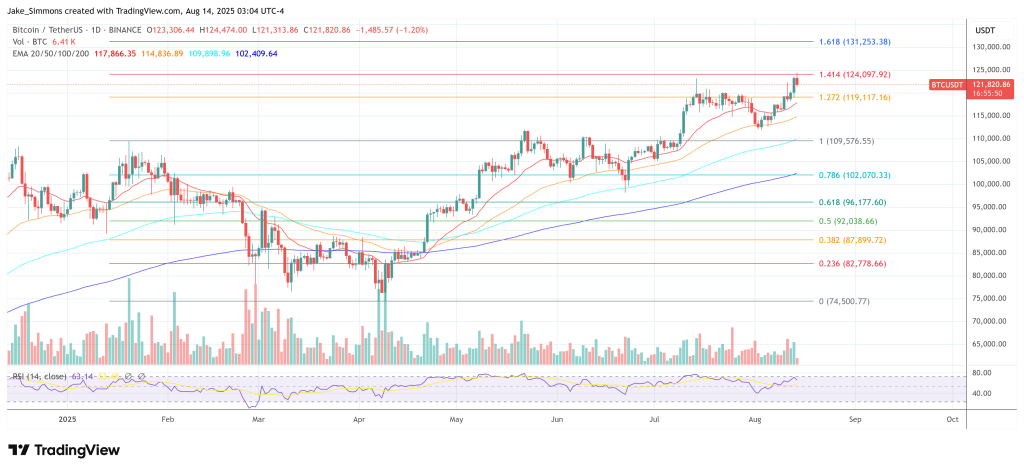Dennis Porter, CEO of the Satoshi Action Fund, ignited a fresh fight over Bitcoin’s identity and governance on Wednesday, arguing that so-called “spam” transactions are bloating the blockchain and, over time, could open the door to protocol changes that erode its most sacrosanct guarantees. “Bloating bitcoin with spam won’t ‘kill’ bitcoin,” Porter wrote on X on August 13. “However, bloating bitcoin with spam WILL allow highly motivated actors to make future changes to bitcoin that undermine its most important principles.” He specified those principles as the “21 million hard supply cap” and “censorship resistance,” and warned that if they are weakened “Bitcoin will just continue on as a hybrid fiat/bitcoin system controlled by a few instead of the many.”
Bitcoin ‘Spam’ Debate Erupts Again
Porter’s core claim is not that extraneous data flows would directly alter monetary policy, but that rising resource demands to validate the chain would steadily reduce the number of full node operators—tilting power toward developers and economically influential entities. He framed node runners as constitutional backstops: “Node runners are critical stakeholders who act as the ‘Supreme Court’ for Bitcoin. Without a Supreme Court, Congress (developers) can pass whatever laws (rules) they want.” In his view, a thinner “Supreme Court” makes it “easier to make changes to bitcoin that benefit special interest groups and corporations at the loss of users and businesses.”
The pushback was immediate. The pseudonymous Bitcoiner J.Dog argued that labeling the activity as “spam” misses the point that these are, by definition, valid transactions under current consensus rules. “Your second point was censorship resistance but in the same breath trying to censor certain transactions in consensus with the network lol,” he wrote, adding that “You can’t block spam because they are legitimate transactions.”
He tied the present dynamics to the Taproot upgrade rather than any “exploit,” saying, “It’s not an exploit it was taproot integration. You would have to fork off to stop arbitrary data from entering the blockchain.” J.Dog further suggested that higher on-chain activity could be constructive by bolstering miner income: “There’s also an argument to be made that this is positive for the blockchain because it solves the security budget issue by increasing transactions.” In a governance prediction, he contended that if the alternative Bitcoin Knots implementation diverged, “the likely scenario is that Knots gets forked off as the monetary nodes choose to run Core & stay in consensus.”
Porter pushed back on the characterization that nothing is amiss in consensus, insisting that the current pattern of non-monetary inscription-style usage reflects an unfixed issue introduced in code. “Those transactions become ‘in consensus’ through an exploit from an update to the code. That exploit was left unfixed by developers,” he wrote.
When asked to define what constitutes a “Bitcoin” transaction, Porter steered the discussion toward intent and design scope: “It’s not a censorship resistant network for everything. It’s designed to be censorship resistant money. If we make everything censorship resistant then nothing is censorship resistant.” Pressed again on whether “consensus valid” should end the debate, he replied: “If a transaction becomes ‘consensus valid’ through an exploit, should we fix the exploit or do nothing?”
From Bitcoin Core To Knots
The thread broadened as other prominent voices weighed in. Casey (@rodarmor) offered a hard-edged hypothetical about client diversity and safety, quipping: “It’s going to be so funny when a bug in Knots causes a consensus break and nobody notices when they fork off the network because they’re not economically relevant.”
Erik ₿ countered Porter’s framing by invoking the genesis block’s embedded newspaper headline—“The Times 03/Jan/2009 Chancellor on brink of second bailout for banks”—as evidence that non-monetary data has been present since Bitcoin’s inception: “Didn’t Satoshi himself add ‘spam’ (as you call it) to the very first block? … Food for thought…” Porter dismissed the equivalence, writing, “Shoold [sic] we really be comparing the founding message of the importance of a neutral and decentralized monetary network which took up minimal amounts of data to putting monkey photos on chain that use up as much data as possible so they can make a profit? No. No we shouldn’t.”
The more practical question—what to do next—exposed the live fault line between reference and alternative clients. Some respondents warned that any attempt to curtail arbitrary data would require a hard fork, inviting replay of past schisms. Porter resisted that framing, suggesting a migration by operators could realign incentives without a chain split: “We can leave Core for Knots. No fork needed.” His critics responded that “the primary monetary nodes run core,” implying that any unilateral shift by Knots-aligned users would amount to self-exile from the dominant economic network.
Beneath the rhetoric lies an unresolved tension about the scope of Bitcoin’s neutrality. One camp emphasizes immaculate monetary assurances—most notably the 21,000,000 BTC terminal supply—and argues that tolerating data-heavy non-monetary use threatens the broad, decentralized base of validators that anchors those assurances. The other camp stresses that neutrality must apply to any transaction meeting consensus rules, whether value-transfer or data-carriage, and that market forces, not policy-driven filters, should arbitrate blockspace. That side also sees fee pressure as a necessary ingredient in sustaining miner security as block subsidies decline.
At press time, Bitcoin traded at $121,820.

Featured image created with DALL.E, chart from TradingView.com

Editorial Process for bitcoinist is centered on delivering thoroughly researched, accurate, and unbiased content. We uphold strict sourcing standards, and each page undergoes diligent review by our team of top technology experts and seasoned editors. This process ensures the integrity, relevance, and value of our content for our readers.


